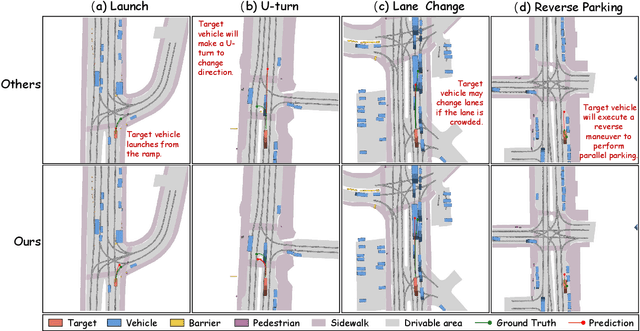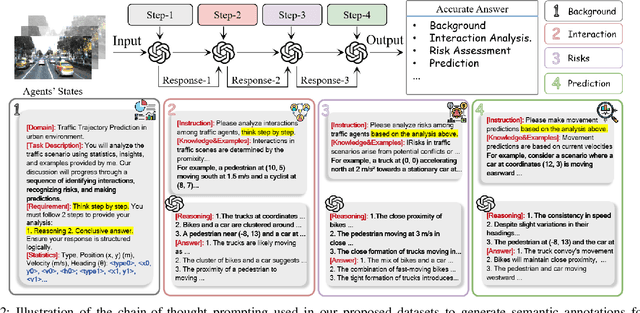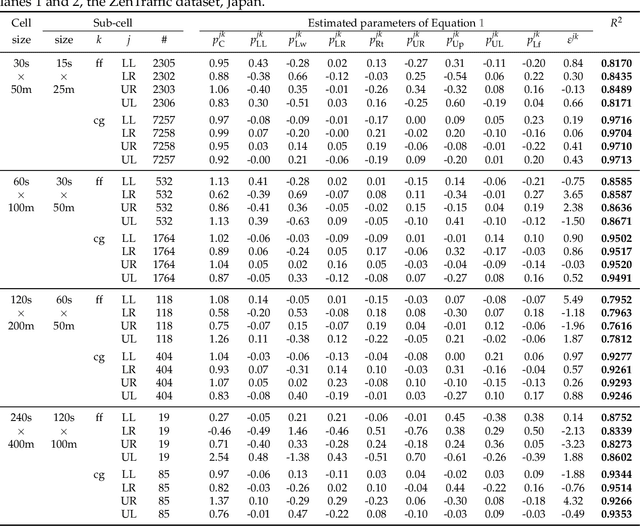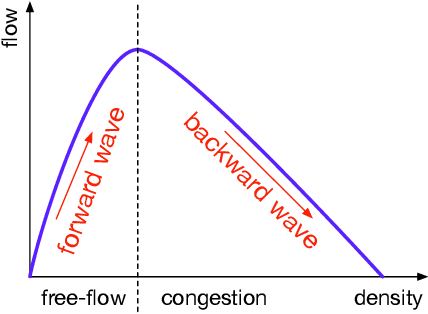Zhengbing He
When Context Is Not Enough: Modeling Unexplained Variability in Car-Following Behavior
Jul 09, 2025Abstract:Modeling car-following behavior is fundamental to microscopic traffic simulation, yet traditional deterministic models often fail to capture the full extent of variability and unpredictability in human driving. While many modern approaches incorporate context-aware inputs (e.g., spacing, speed, relative speed), they frequently overlook structured stochasticity that arises from latent driver intentions, perception errors, and memory effects -- factors that are not directly observable from context alone. To fill the gap, this study introduces an interpretable stochastic modeling framework that captures not only context-dependent dynamics but also residual variability beyond what context can explain. Leveraging deep neural networks integrated with nonstationary Gaussian processes (GPs), our model employs a scenario-adaptive Gibbs kernel to learn dynamic temporal correlations in acceleration decisions, where the strength and duration of correlations between acceleration decisions evolve with the driving context. This formulation enables a principled, data-driven quantification of uncertainty in acceleration, speed, and spacing, grounded in both observable context and latent behavioral variability. Comprehensive experiments on the naturalistic vehicle trajectory dataset collected from the German highway, i.e., the HighD dataset, demonstrate that the proposed stochastic simulation method within this framework surpasses conventional methods in both predictive performance and interpretable uncertainty quantification. The integration of interpretability and accuracy makes this framework a promising tool for traffic analysis and safety-critical applications.
A Survey on Data-Driven Modeling of Human Drivers' Lane-Changing Decisions
May 10, 2025Abstract:Lane-changing (LC) behavior, a critical yet complex driving maneuver, significantly influences driving safety and traffic dynamics. Traditional analytical LC decision (LCD) models, while effective in specific environments, often oversimplify behavioral heterogeneity and complex interactions, limiting their capacity to capture real LCD. Data-driven approaches address these gaps by leveraging rich empirical data and machine learning to decode latent decision-making patterns, enabling adaptive LCD modeling in dynamic environments. In light of the rapid development of artificial intelligence and the demand for data-driven models oriented towards connected vehicles and autonomous vehicles, this paper presents a comprehensive survey of data-driven LCD models, with a particular focus on human drivers LC decision-making. It systematically reviews the modeling framework, covering data sources and preprocessing, model inputs and outputs, objectives, structures, and validation methods. This survey further discusses the opportunities and challenges faced by data-driven LCD models, including driving safety, uncertainty, as well as the integration and improvement of technical frameworks.
MM-STFlowNet: A Transportation Hub-Oriented Multi-Mode Passenger Flow Prediction Method via Spatial-Temporal Dynamic Graph Modeling
Apr 08, 2025Abstract:Accurate and refined passenger flow prediction is essential for optimizing the collaborative management of multiple collection and distribution modes in large-scale transportation hubs. Traditional methods often focus only on the overall passenger volume, neglecting the interdependence between different modes within the hub. To address this limitation, we propose MM-STFlowNet, a comprehensive multi-mode prediction framework grounded in dynamic spatial-temporal graph modeling. Initially, an integrated temporal feature processing strategy is implemented using signal decomposition and convolution techniques to address data spikes and high volatility. Subsequently, we introduce the Spatial-Temporal Dynamic Graph Convolutional Recurrent Network (STDGCRN) to capture detailed spatial-temporal dependencies across multiple traffic modes, enhanced by an adaptive channel attention mechanism. Finally, the self-attention mechanism is applied to incorporate various external factors, further enhancing prediction accuracy. Experiments on a real-world dataset from Guangzhounan Railway Station in China demonstrate that MM-STFlowNet achieves state-of-the-art performance, particularly during peak periods, providing valuable insight for transportation hub management.
Estimating City-wide operating mode Distribution of Light-Duty Vehicles: A Neural Network-based Approach
Mar 28, 2025



Abstract:Driving cycles are a set of driving conditions and are crucial for the existing emission estimation model to evaluate vehicle performance, fuel efficiency, and emissions, by matching them with average speed to calculate the operating modes, such as braking, idling, and cruising. While existing emission estimation models, such as the Motor Vehicle Emission Simulator (MOVES), are powerful tools, their reliance on predefined driving cycles can be limiting, as these cycles often do not accurately represent regional driving conditions, making the models less effective for city-wide analyses. To solve this problem, this paper proposes a modular neural network (NN)-based framework to estimate operating mode distributions bypassing the driving cycle development phase, utilizing macroscopic variables such as speed, flow, and link infrastructure attributes. The proposed method is validated using a well-calibrated microsimulation model of Brookline MA, the United States. The results indicate that the proposed framework outperforms the operating mode distribution calculated by MOVES based on default driving cycles, providing a closer match to the actual operating mode distribution derived from trajectory data. Specifically, the proposed model achieves an average RMSE of 0.04 in predicting operating mode distribution, compared to 0.08 for MOVES. The average error in emission estimation across pollutants is 8.57% for the proposed method, lower than the 32.86% error for MOVES. In particular, for the estimation of CO2, the proposed method has an error of just 4%, compared to 35% for MOVES. The proposed model can be utilized for real-time emissions monitoring by providing rapid and accurate emissions estimates with easily accessible inputs.
CoT-Drive: Efficient Motion Forecasting for Autonomous Driving with LLMs and Chain-of-Thought Prompting
Mar 10, 2025



Abstract:Accurate motion forecasting is crucial for safe autonomous driving (AD). This study proposes CoT-Drive, a novel approach that enhances motion forecasting by leveraging large language models (LLMs) and a chain-of-thought (CoT) prompting method. We introduce a teacher-student knowledge distillation strategy to effectively transfer LLMs' advanced scene understanding capabilities to lightweight language models (LMs), ensuring that CoT-Drive operates in real-time on edge devices while maintaining comprehensive scene understanding and generalization capabilities. By leveraging CoT prompting techniques for LLMs without additional training, CoT-Drive generates semantic annotations that significantly improve the understanding of complex traffic environments, thereby boosting the accuracy and robustness of predictions. Additionally, we present two new scene description datasets, Highway-Text and Urban-Text, designed for fine-tuning lightweight LMs to generate context-specific semantic annotations. Comprehensive evaluations of five real-world datasets demonstrate that CoT-Drive outperforms existing models, highlighting its effectiveness and efficiency in handling complex traffic scenarios. Overall, this study is the first to consider the practical application of LLMs in this field. It pioneers the training and use of a lightweight LLM surrogate for motion forecasting, setting a new benchmark and showcasing the potential of integrating LLMs into AD systems.
NeuralMOVES: A lightweight and microscopic vehicle emission estimation model based on reverse engineering and surrogate learning
Feb 06, 2025



Abstract:The transportation sector significantly contributes to greenhouse gas emissions, necessitating accurate emission models to guide mitigation strategies. Despite its field validation and certification, the industry-standard Motor Vehicle Emission Simulator (MOVES) faces challenges related to complexity in usage, high computational demands, and its unsuitability for microscopic real-time applications. To address these limitations, we present NeuralMOVES, a comprehensive suite of high-performance, lightweight surrogate models for vehicle CO2 emissions. Developed based on reverse engineering and Neural Networks, NeuralMOVES achieves a remarkable 6.013% Mean Average Percentage Error relative to MOVES across extensive tests spanning over two million scenarios with diverse trajectories and the factors regarding environments and vehicles. NeuralMOVES is only 2.4 MB, largely condensing the original MOVES and the reverse engineered MOVES into a compact representation, while maintaining high accuracy. Therefore, NeuralMOVES significantly enhances accessibility while maintaining the accuracy of MOVES, simplifying CO2 evaluation for transportation analyses and enabling real-time, microscopic applications across diverse scenarios without reliance on complex software or extensive computational resources. Moreover, this paper provides, for the first time, a framework for reverse engineering industrial-grade software tailored specifically to transportation scenarios, going beyond MOVES. The surrogate models are available at https://github.com/edgar-rs/neuralMOVES.
AI-Driven Day-to-Day Route Choice
Dec 04, 2024



Abstract:Understanding travelers' route choices can help policymakers devise optimal operational and planning strategies for both normal and abnormal circumstances. However, existing choice modeling methods often rely on predefined assumptions and struggle to capture the dynamic and adaptive nature of travel behavior. Recently, Large Language Models (LLMs) have emerged as a promising alternative, demonstrating remarkable ability to replicate human-like behaviors across various fields. Despite this potential, their capacity to accurately simulate human route choice behavior in transportation contexts remains doubtful. To satisfy this curiosity, this paper investigates the potential of LLMs for route choice modeling by introducing an LLM-empowered agent, "LLMTraveler." This agent integrates an LLM as its core, equipped with a memory system that learns from past experiences and makes decisions by balancing retrieved data and personality traits. The study systematically evaluates the LLMTraveler's ability to replicate human-like decision-making through two stages: (1) analyzing its route-switching behavior in single origin-destination (OD) pair congestion game scenarios, where it demonstrates patterns align with laboratory data but are not fully explained by traditional models, and (2) testing its capacity to model day-to-day (DTD) adaptive learning behaviors on the Ortuzar and Willumsen (OW) network, producing results comparable to Multinomial Logit (MNL) and Reinforcement Learning (RL) models. These experiments demonstrate that the framework can partially replicate human-like decision-making in route choice while providing natural language explanations for its decisions. This capability offers valuable insights for transportation policymaking, such as simulating traveler responses to new policies or changes in the network.
Will Large Language Models be a Panacea to Autonomous Driving?
Sep 24, 2024



Abstract:Artificial intelligence (AI) plays a crucial role in autonomous driving (AD) research, propelling its development towards intelligence and efficiency. Currently, the development of AD technology follows two main technical paths: modularization and end-to-end. Modularization decompose the driving task into modules such as perception, prediction, planning, and control, and train them separately. Due to the inconsistency of training objectives between modules, the integrated effect suffers from bias. End-to-end attempts to address this issue by utilizing a single model that directly maps from sensor data to control signals. This path has limited learning capabilities in a comprehensive set of features and struggles to handle unpredictable long-tail events and complex urban traffic scenarios. In the face of challenges encountered in both paths, many researchers believe that large language models (LLMs) with powerful reasoning capabilities and extensive knowledge understanding may be the solution, expecting LLMs to provide AD systems with deeper levels of understanding and decision-making capabilities. In light of the challenges faced by both paths, many researchers believe that LLMs, with their powerful reasoning abilities and extensive knowledge, could offer a solution. To understand if LLMs could enhance AD, this paper conducts a thorough analysis of the potential applications of LLMs in AD systems, including exploring their optimization strategies in both modular and end-to-end approaches, with a particular focus on how LLMs can tackle the problems and challenges present in current solutions. Furthermore, we discuss an important question: Can LLM-based artificial general intelligence (AGI) be a key to achieve high-level AD? We further analyze the potential limitations and challenges that LLMs may encounter in promoting the development of AD technology.
Large-Scale Traffic Data Imputation with Spatiotemporal Semantic Understanding
Jan 27, 2023Abstract:Large-scale data missing is a challenging problem in Intelligent Transportation Systems (ITS). Many studies have been carried out to impute large-scale traffic data by considering their spatiotemporal correlations at a network level. In existing traffic data imputations, however, rich semantic information of a road network has been largely ignored when capturing network-wide spatiotemporal correlations. This study proposes a Graph Transformer for Traffic Data Imputation (GT-TDI) model to impute large-scale traffic data with spatiotemporal semantic understanding of a road network. Specifically, the proposed model introduces semantic descriptions consisting of network-wide spatial and temporal information of traffic data to help the GT-TDI model capture spatiotemporal correlations at a network level. The proposed model takes incomplete data, the social connectivity of sensors, and semantic descriptions as input to perform imputation tasks with the help of Graph Neural Networks (GNN) and Transformer. On the PeMS freeway dataset, extensive experiments are conducted to compare the proposed GT-TDI model with conventional methods, tensor factorization methods, and deep learning-based methods. The results show that the proposed GT-TDI outperforms existing methods in complex missing patterns and diverse missing rates. The code of the GT-TDI model will be available at https://github.com/KP-Zhang/GT-TDI.
Refining time-space traffic diagrams: A multiple linear regression model
Apr 09, 2022



Abstract:A time-space traffic (TS) diagram that presents traffic states in time-space cells with colors is one of the most important traffic analysis and visualization tools. Despite its importance for transportation research and engineering, most TS diagrams that have already existed or are being produced are too coarse to exhibit detailed traffic dynamics due to the limitation of the current information technology and traffic infrastructure investment. To increase the resolution of a TS diagram and make it present more traffic details, this paper introduces a TS diagram refinement problem and proposes a multiple linear regression-based model to solve the problem. Two tests, which attempt to increase the resolution of a TS diagram for 4 and 16 times, respectively, are carried out to evaluate the performance of the proposed model. The data collected from different time, different location and even different country is involved to thoroughly evaluate the accuracy and transferability of the proposed model. The strict tests with diverse data show that the proposed model, although it is simple in form, is able to refine a TS diagram with a promising accuracy and reliable transferability. The proposed refinement model will "save" those widely-existing TS diagrams from their blurry "faces" and make it possible to learn more traffic details from those TS diagrams.
 Add to Chrome
Add to Chrome Add to Firefox
Add to Firefox Add to Edge
Add to Edge